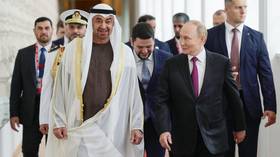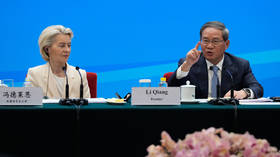Beijing’s rapid military modernization fuels debate, but closer scrutiny reveals a more complex and nuanced defense strategy
Over the past two decades, China has made remarkable progress in the development of its defense and military capabilities.
Once heavily dependent on military imports and foreign technologies, Beijing has gradually moved toward self-sufficiency. This shift is evident in recent technological breakthroughs across multiple domains, including the domestic production of advanced fighter aircraft, frigates, aircraft carriers, hypersonic missiles, and unmanned systems. At the same time, China has articulated a distinct vision for the future of warfare, one that emphasizes artificial intelligence (AI), autonomous systems, multidomain integration, and “intelligent,” or cognitive, warfare.
For Washington and its allies, this progress has set off alarm bells. Military planners in the United States have mobilized new resources to contain China, expand alliance structures, and accelerate an arms buildup. The result has been the familiar cycle of security dilemmas and arms races that has characterized other periods of global competition. Yet such assessments of China’s military trajectory are misleading. They tend to inflate the so-called “China threat” narrative and frame Beijing’s actions solely in terms of a zero-sum struggle for hegemony.
In reality, the modernization of the People’s Liberation Army (PLA) is an extension of China’s broader reforms and an expression of its rise as a major power. By many measures, China’s military capabilities still lag significantly behind those of other great powers, particularly the US, and remain disproportionate to its global economic and political weight.
From the beginning of his tenure, Xi Jinping made comprehensive military reform a central priority. His program included not only the modernization of equipment, but also far-reaching institutional and strategic reforms aimed at increasing efficiency and strengthening command structures. Importantly, Western commentators often overlook that Xi’s reforms began with austerity measures, including a reduction of troop numbers by 300,000. Such measures highlighted that Beijing’s approach was not merely about accumulation of power but about recalibration, optimization, and efficiency.
The current Chinese military doctrine is “Xi Jinping Thought on Strengthening the Military,” adopted in 2017. This doctrine sets the ambitious goal of transforming the PLA into a world-class military by 2049, with major milestones expected by 2027, the centenary of the PLA’s founding. Some Western strategists have seized on this timeline to propagate the narrative that Beijing intends to invade Taiwan by 2027.
This claim, however, lacks substantiation and functions largely as a justification for higher military spending and continued arms races in the region. Chinese modernization is not designed for imminent aggression but rather for building sufficient strength to deter foreign interference, safeguard national sovereignty, and secure long-term development interests.
Another defining feature of Xi’s reforms has been the strengthening of Communist Party’s control over the PLA. Party leadership over the military has been a principle since 1927, though it has occasionally weakened, particularly during the upheavals of the Cultural Revolution. Xi has reasserted the principle of absolute party leadership through the Central Military Commission (CMC), of which he is the only civilian representative. Alongside institutional restructuring, Xi launched a sweeping anti-corruption campaign within the military, which has reached even the CMC itself. Several senior figures have been dismissed in recent years, with the latest case emerging as recently as June.
At the same time, China has elevated innovation and advanced technology as central to military modernization. Official documents began incorporating the concept of “intelligent warfare” in 2019, emphasizing the integration of AI, autonomous systems, and human-machine teaming. This marks a strategic shift toward the cognitive domain as a critical theater of operations, complementing the traditional physical and information spheres. The vision is of multidomain, integrated warfare, underpinned by the Internet of Things (IoT), machine autonomy, and human-machine integration – an innovative elaboration of China’s long-standing principle of “active defense.”
Speculation now surrounds which new systems will be showcased during the upcoming Victory Day parade on September 3 in Tiananmen Square. The anticipation reflects the scale of recent achievements across several domains.

In aviation, China has begun testing sixth-generation fighters, the J-36 and J-50, which appeared publicly in December 2024. Although Beijing has not officially acknowledged their existence, reports suggest these platforms could represent a major leap forward in stealth, speed, and adaptability. Since 2024, China has also become the only country besides the US to operate two types of stealth fighter jets.
China is widely regarded as a global hypersonic missile leader. These systems, capable of traveling at extreme speeds and maneuvering unpredictably, pose serious challenges to existing defense networks. Beijing is investing in both conventional and nuclear-armed hypersonic technologies, underscoring their strategic importance.
Unmanned systems are also moving rapidly to the forefront. Chinese strategists increasingly see drones and robotic systems as potentially decisive elements of any future conflict. Recent developments include swarming drones inspired by the structure of maple seeds, miniature mosquito-sized bionic robots for reconnaissance and covert operations, and the drone carrier “Nine Heavens,” which can launch up to 100 drones simultaneously to overwhelm defenses. In August 2025, China unveiled the world’s first high-speed vertical take-off and landing drone powered by a jet engine, designed to transform ordinary warships into ad hoc aircraft carriers. Military drills in July demonstrated another innovation: robotic quadrupeds paired with aerial drones for coordinated operations.
Naval power remains a strategic priority. After decades of ambition, China now operates two aircraft carriers – Liaoning and Shandong – soon to be joined by the domestically designed Fujian, currently undergoing sea trials and expected to enter service in late 2025. Construction has already begun on the Type 004, which will be China’s first nuclear-powered carrier. Although the US still maintains a significant lead with 11 nuclear-powered carriers, China is narrowing the gap. Beyond carriers, new assets include the Type 054B frigates Luohe and Qinzhou, launched in 2023 and commissioned in 2025, as well as the Type 076 amphibious assault ship launched in late 2024. Development also continues on the Type 096 nuclear submarine, described by Western analysts as a potential “nightmare” for US planners.

Most recently, China unveiled the “Bohai Sea Monster,” a wing-in-ground effect craft that straddles the line between ship and aircraft, capable of traveling faster than conventional vessels while evading radar detection. Despite these achievements, Beijing still lacks a global logistics network and advanced nuclear submarine technologies, underscoring that its naval power remains regionally concentrated.
China’s nuclear arsenal is also expanding, with estimates suggesting an annual growth of roughly 100 warheads. By 2030, the stockpile could exceed 1,000 warheads, many of them capable of striking the continental United States. Nevertheless, China maintains a declared doctrine of no first use and pledges never to use or threaten nuclear weapons against non-nuclear states or nuclear-weapon-free zones. In the long term, Beijing continues to advocate for the complete prohibition and eventual elimination of nuclear weapons – a position that distinguishes its official stance from those of Washington and Moscow.
Taken together, these developments illustrate a profound transformation of the PLA. Yet they also highlight the gap between perception and reality. While China’s military modernization has undeniably accelerated, it is driven not by expansionist ambitions but by the desire to safeguard sovereignty, deter external threats, and match its global economic stature with corresponding defensive capabilities. Western alarmism, particularly the fixation on a Taiwan invasion timeline, risks misinterpreting Beijing’s intentions and fueling a destabilizing arms race.
The PLA of the future will be more technologically advanced, more integrated across multiple domains, and more tightly bound to the political leadership of the Communist Party. But its primary role will remain defensive: to deter foreign coercion, protect China’s interests, and ensure space for peaceful development and coexistence. Recognizing this reality requires moving beyond the “China threat” narrative and toward a balanced assessment – one that acknowledges both the significance of China’s military modernization and the limits of its current capabilities. Only then can the international community avoid a self-fulfilling cycle of mistrust and confrontation.
Read the full article here
